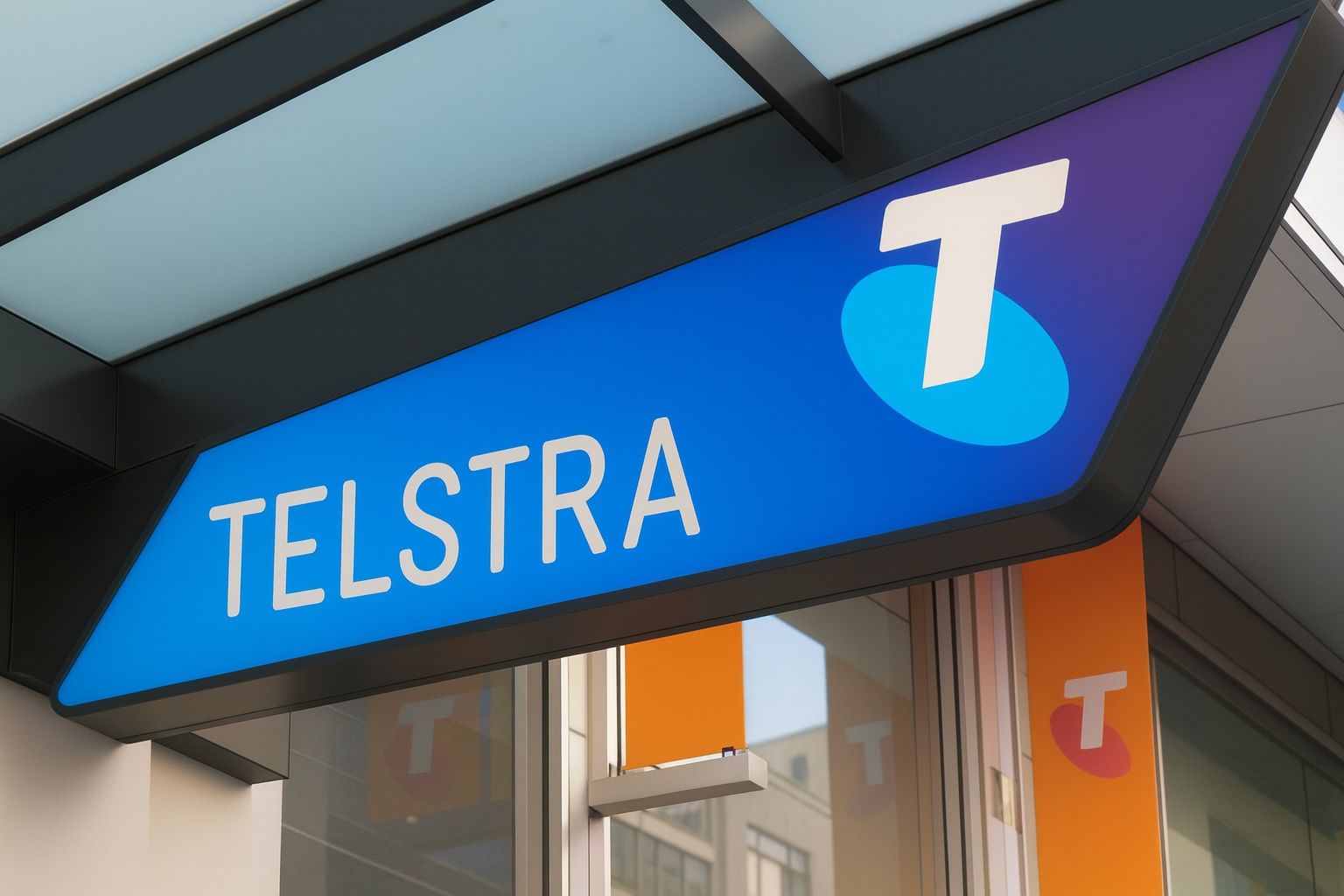As the Australian share market prepares to open on Monday, 17 November 2025, Telstra Group Limited (still commonly referred to as Telstra Corporation Limited and trading under the ticker ASX: TLS) will be on a lot of watchlists.
The Telstra share price closed at A$4.94 on Friday, 14 November 2025, down 0.6% for the day, with a trading range of A$4.92–4.97 and volume around 15.5 million shares, slightly below its average of ~21.6 million. [1] The stock is trading near the upper end of its 52‑week range of A$3.82–5.14, giving Telstra a market capitalisation of roughly A$56 billion, a trailing P/E of about 26x, and a dividend yield around 3.8–3.9% on A$0.19 per share in fully franked dividends. [2]
Over the past five years, Telstra has delivered a total shareholder return (including dividends) of about 99%, with the share price itself up around 60% in that period and roughly 30% above its 52‑week low. [3] That mix of defensive cash flow, rising dividends and a large buy-back is exactly why Telstra is being closely watched before the bell.
Below is what investors may want to know about Telstra stock heading into Monday’s ASX open.
1. Telstra share price snapshot before Monday’s open
- Last close (14 Nov 2025): A$4.94
- Day move: –0.03 (–0.6%)
- Day range: A$4.92–4.97
- 52‑week range: A$3.82–5.14
- Market cap: ~A$55.8–55.9 billion
- Trailing EPS: ~A$0.19
- Trailing P/E: ~26x
- Dividend (FY25): A$0.19 per share (fully franked), yield ~3.8–3.9%
- Beta: ~0.16 (low volatility vs broader market) [4]
Price data show Telstra shares have risen around 25–30% over the past year, and are trading more than 30% above the 52‑week low, reinforcing its position as a defensive, income-focused blue chip that has still delivered decent capital growth. [5]
For Monday’s open, A$4.90–5.00 looks like a key near-term battleground zone, with resistance near recent highs around A$5.10–5.14 and support built by repeated buy-back activity in the high A$4s. [6]
2. Aggressive share buy-back is supporting TLS stock
One of the biggest near-term drivers of the Telstra share price is its large on-market share buy-back program.
- In August 2025, Telstra announced a new A$1 billion on-market share buy-back, just six months after completing a A$750 million buy-back earlier in the year. [7]
- The new program is scheduled to run from 9 September 2025 to 30 June 2026, according to ASX filings. [8]
- Daily ASX “Update – Notification of buy-back” notices show steady purchases through October and November, with a cumulative 57.8 million+ shares bought back reported by late October, and further daily buying into mid‑November. [9]
For investors, this matters because:
- A buy-back of this size reduces the share count, which is typically EPS-accretive and can support the share price over time.
- Management is signalling confidence in the balance sheet and cash generation – Telstra is using excess capital from operations and portfolio reshaping (more on that below) to return cash to shareholders. [10]
- The steady drumbeat of daily buy-back orders has created an underlying bid in the high A$4s, helping the stock consolidate after a strong multi-year run.
Before Monday’s open, investors will be watching for any new buy-back notifications lodged after Friday’s close, as they help gauge how aggressively Telstra is supporting the stock on-market.
3. FY25 results: profit jump, steady revenue and higher dividends
Telstra’s full-year 2025 results (year to 30 June 2025) underpin much of the current bullishness – but they also explain some of the market caution.
Key FY25 headlines:
- Statutory profit rose about 31% year-on-year to roughly A$2.3–2.34 billion, in line with market expectations. [11]
- Revenue was broadly flat at around A$23–23.6 billion, with strong growth in mobile offsetting weaker enterprise and international segments. [12]
- Underlying operating earnings (EBITDA after lease amortisation) came in around A$8.6 billion, up roughly 14% year-on-year. [13]
- Business-as-usual capex was about A$3.4 billion, reflecting heavy investment in 5G, fibre and network upgrades. [14]
Dividends and yield:
- Telstra declared a final dividend of 9.5 cents per share, up from 9 cents the prior year, bringing the full-year dividend to 19 cents, a 5.6% increase year-on-year. [15]
- At Friday’s close, that translates to a trailing dividend yield of roughly 3.8–3.9%, fully franked, which is being widely cited in local commentary as a key attraction for income investors. [16]
Guidance and market reaction:
- For FY26, Telstra guided to underlying EBITDA (post-leases) of A$8.15–8.45 billion, versus A$8.02 billion in FY25 – implying only modest growth and slightly below prior consensus at the midpoint, which sat around A$8.44 billion. [17]
- Analysts noted the new guidance metrics and framing made direct comparisons trickier, leading some brokers to trim estimates and contributing to a share price pullback immediately after results. [18]
Heading into Monday, investors will still be weighing a strong FY25 profit and dividend uplift against the more conservative FY26 earnings outlook.
4. Strategy update: 5G, AI and data centres in focus
Telstra’s “Connected Future 30” strategy and network investments are central to the long-term story behind the TLS share price.
4.1 5G standalone and network slicing
At the “5G Evolution” event in November, Telstra’s technology leadership reiterated that 5G standalone (SA) is critical to the company’s future. [19]
Key points:
- Telstra aims to have all major Australian cities covered with 5G standalone by the end of 2025. [20]
- The company is already rolling out network slicing products for enterprises, starting with priority slices in congested environments (for example, stadiums and large venues), and plans to extend this to dynamic handset-level slicing. [21]
From an investment perspective, 5G SA and slicing matter because they:
- Enable differentiated enterprise offerings (e.g. mission-critical connectivity, IoT, edge computing).
- Support higher-margin services beyond commodity mobile data, a key lever for earnings growth over the next decade.
4.2 Data centre and AI infrastructure
Only days before Monday’s session, Telstra announced it will contribute land and connectivity via its InfraCo arm to a new 62MW data centre development in Minchinbury, western Sydney, in partnership with Starwood Capital Group and Singapore’s Doma Infrastructure Group. [22]
- Starwood and Doma will fund, develop and operate the carrier-neutral, Tier III facility, which sits next to the Eastern Creek data centre cluster.
- Construction is expected to start in early 2026, with target commissioning in early 2028 as a hyperscale‑ready site geared for AI workloads and high-density computing. [23]
This move aligns with Telstra’s messaging around:
- Capital-light exposure to the booming AI and data centre ecosystem. [24]
- Leveraging its network and real estate assets without shouldering all the capex and operational risk.
4.3 SpaceX, cloud carve-outs and portfolio reshaping
Other strategic moves investors are tracking:
- A mobile-to-satellite partnership with SpaceX’s Starlink to allow text messages via satellite across much of Australia, a deal that helped push Telstra shares to their highest level in about 8.5 years when announced earlier in 2025. [25]
- The sale of a 75% stake in cloud services business Versent Group to Infosys for about A$233 million, shifting 650 staff and freeing capital to help fund the buy-back while sharpening Telstra’s focus on core connectivity and infrastructure. [26]
- A September deal for U.S. firm iBASIS to acquire Telstra International’s wholesale voice, mobile and messaging customer contracts, plus rights to international wholesale voice services for Digicel Pacific, further slimming Telstra’s global wholesale footprint. [27]
For investors, these moves collectively point to a Telstra that is:
- Doubling down on its core networks, spectrum and infrastructure advantage in Australia.
- Using asset sales to recycle capital into shareholder returns and focused growth initiatives.
5. Regulatory and reputational headwinds
The positive earnings and capital management story is tempered by regulatory and reputational risks, which remain important considerations before buying or selling TLS.
5.1 ACCC fine over internet speeds
On 3 October 2025, the Australian Competition and Consumer Commission (ACCC) announced that Telstra had been fined A$18 million by the Federal Court. The regulator found that Telstra’s low-cost brand Belong had migrated 8,897 customers onto lower-speed broadband plans without telling them their maximum upload speed was halved, back in 2020. [28]
Telstra has:
- Accepted the court’s findings.
- Either credited or is crediting affected customers with A$15 per month for the period they were on the lower-speed plan. [29]
While the fine is not financially material for a company of Telstra’s size, it reinforces:
- Ongoing ACCC scrutiny of telco conduct.
- The importance of customer trust for a brand that positions itself as premium.
5.2 Spectrum decision could push up bills
Just this week, Telstra warned that if the Australian Communications and Media Authority (ACMA) decides to auction expiring mobile spectrum licences instead of renewing them at benchmark fees, it may be forced to raise mobile prices and slow network upgrades. [30]
- More than 80% of current spectrum licences are due to expire between 2028 and 2032.
- Telstra, Optus and TPG all favour renewals at benchmark fees, arguing that inflated auction prices would choke investment. [31]
- Consumer advocates counter that auctions could raise billions in additional public revenue and strengthen competition.
For Telstra shareholders, the ACMA decision (and any government intervention) could materially influence:
- Long-term capex requirements and returns,
- Pricing power, and
- Competitive dynamics in Australian mobile.
It’s a medium-term risk, but the market is already starting to price in regulatory uncertainty around spectrum, which investors may factor into valuations before Monday’s open.
5.3 Emergency call reliability and broader scrutiny
Telstra, along with other carriers, is also facing political and regulatory pressure over triple-zero (000) emergency call reliability, particularly after high-profile outages at rival Optus. Government and regulators have flagged closer oversight and potential consequences for failures around critical services. [32]
Any mandated upgrades or penalties could:
- Increase Telstra’s compliance and infrastructure costs, but
- Also reinforce its role as the “safe pair of hands” in Australian telecommunications if it executes better than rivals.
6. Cost-cutting, AI and jobs: efficiency vs execution risk
Another theme behind Telstra’s improved profitability is cost-cutting and automation, which carries both upside and risk.
- In 2025, Telstra confirmed it will cut 550 roles (around 2% of its 31,000‑strong workforce), as part of a “reset” of its enterprise division and broader organisational changes. [33]
- This follows an earlier program announced in 2024 that planned up to 2,800 job cuts, later trimmed to about 1,900, aimed at saving roughly A$350 million. [34]
- Separately, Telstra has outlined plans to gradually shrink its workforce through 2030 as it leans heavily on AI and automation in customer service, billing, software development and operations, under its Connected Future 30 strategy. [35]
For shareholders, the upside is clear:
- Lower headcount and AI-enabled efficiencies can support margins and free up capital for dividends and buy-backs.
But there are also real risks:
- Employee morale, union relations and brand perception could suffer if cuts are perceived as too aggressive or if service levels deteriorate.
- Execution missteps in complex AI and automation rollouts could create IT or customer service disruptions, which regulators are increasingly sensitive to.
Heading into Monday, none of this is “new” news, but it forms an important part of how the market prices Telstra’s medium-term earnings power vs. operational risk.
7. How the market currently views Telstra shares
7.1 Strong long-term total returns and improving sentiment
Analysis from Simply Wall St highlights that over the last five years, Telstra’s share price has increased around 60%, while total shareholder return (including reinvested dividends) is about 99%, implying that dividends have been a major contributor to investor outcomes. [36]
The same analysis notes:
- Total shareholder return of around 32% over the last 12 months (including dividends), which is higher than the 5‑year annualised TSR, suggesting sentiment has improved more recently. [37]
7.2 Defensive income play with moderate growth
Investment commentary from local outlets such as Kalkine and The Motley Fool consistently highlights Telstra as: [38]
- A defensive, low‑beta stock with relatively stable earnings and cash flows,
- Offering fully franked dividends with potential for gradual growth, and
- Now trading at a premium to its 52‑week lows, reflecting improved confidence post‑T25 and into Connected Future 30.
At the same time, analysts from Morgans, Jefferies and others have flagged that:
- FY25 results were solid but not spectacular, broadly in line with expectations. [39]
- FY26 guidance, while positive, sits only modestly above FY25 earnings and slightly below the prior consensus at the midpoint, which has led to some trimming of forecasts and tempering of growth expectations. [40]
Put simply: the market largely sees Telstra as a quality, income-generating telco with low volatility, backed by strong assets and improving profitability – but not a hyper‑growth story.
8. Key things to watch before the ASX opens on 17 November 2025
Here are the main factors Telstra investors may want to watch heading into Monday’s trade:
- Opening print vs Friday’s close
Does TLS open above or below A$4.94? Friday’s range of A$4.92–4.97 and lighter volume (15.5m vs ~21.6m average) suggests short-term consolidation around current levels. A firm open above A$4.95 could indicate renewed buying interest. [41] - Fresh buy-back notifications
Any new ASX “Update – Notification of buy-back” lodged after Friday will show how active Telstra remains in the market and at what prices it is comfortable buying. Persistent daily purchases are likely to keep downside limited unless there is a major macro or sector shock. [42] - News flow on spectrum policy
With Telstra openly warning about the impact of spectrum auctions on prices and investment, investors should watch for ACMA updates, political commentary or budget leakages that hint at which way the decision is heading. [43] - Reaction to the new data centre partnership
The Minchinbury 62MW data centre JV with Starwood and Doma was announced only days ago. Watch for any broker notes or institutional commentary that re-rate Telstra’s positioning in AI and data centre infrastructure as markets digest the news. [44] - Ongoing regulatory and ACCC headlines
The A$18m ACCC fine and triple-zero scrutiny keep Telstra on regulators’ radar. Any further enforcement actions or undertakings could nudge sentiment, even if the financial impacts are modest. [45] - Sector moves and rotation into/out of defensives
Telstra often trades as a defensive bond proxy. If global markets move sharply on interest-rate expectations or risk sentiment, TLS could move in sympathy with other yield stocks, even in the absence of Telstra-specific news. - Upcoming catalysts
While not immediate for Monday, it’s worth noting that Telstra’s next major scheduled event is its half-year FY26 results on 19 February 2026, followed by interim dividend timing and any guidance updates. [46]
Final word (and a quick disclaimer)
As of Friday’s close, Telstra enters Monday’s session as:
- A large-cap, low-volatility telco with improving profitability,
- Backed by a very active A$1 billion share buy-back,
- Offering a fully franked yield near 4%, and
- Balancing strategic 5G/AI/data centre growth opportunities against regulatory, spectrum and execution risks.
Whether that makes TLS a buy, hold or sell before the ASX opens on 17 November 2025 depends on your risk tolerance, income needs, time horizon and overall portfolio.
This article is general information only and not financial advice. It doesn’t take into account your personal objectives, financial situation or needs. Consider speaking with a licensed financial adviser before making investment decisions.
References
1. stockanalysis.com, 2. stockanalysis.com, 3. simplywall.st, 4. stockanalysis.com, 5. www.tradingview.com, 6. www.investing.com, 7. www.reuters.com, 8. www.listcorp.com, 9. www.intelligentinvestor.com.au, 10. www.mobileworldlive.com, 11. www.reuters.com, 12. www.mobileworldlive.com, 13. www.reuters.com, 14. www.telstra.com.au, 15. www.finnewsnetwork.com.au, 16. stockanalysis.com, 17. www.reuters.com, 18. www.finnewsnetwork.com.au, 19. www.mobileworldlive.com, 20. www.mobileworldlive.com, 21. www.mobileworldlive.com, 22. www.mingtiandi.com, 23. www.mingtiandi.com, 24. www.news.com.au, 25. www.marketscreener.com, 26. www.mobileworldlive.com, 27. www.reuters.com, 28. www.reuters.com, 29. www.reuters.com, 30. www.theaustralian.com.au, 31. www.theaustralian.com.au, 32. stockanalysis.com, 33. www.news.com.au, 34. www.news.com.au, 35. www.theguardian.com, 36. simplywall.st, 37. simplywall.st, 38. kalkinemedia.com, 39. www.finnewsnetwork.com.au, 40. www.finnewsnetwork.com.au, 41. stockanalysis.com, 42. www.marketindex.com.au, 43. www.theaustralian.com.au, 44. www.mingtiandi.com, 45. www.reuters.com, 46. stockanalysis.com









